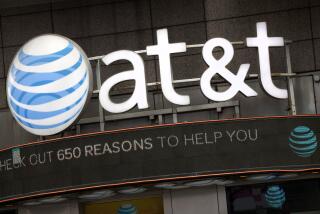Rivals Wince in Pain as FCC Squeezes AT
Not long ago, callers who succeeded in getting past the chronic busy signals on Sprint’s old, overtaxed long-distance network often still had a hard time hearing anything at the other end of the line. And what they did hear echoed maddeningly.
Now the carrier, touting the quality of the 23,000 miles of technologically advanced fiber-optic cable it is feverishly installing nationwide, claims in a television commercial that “you can hear a pin drop” across its long-distance system.
US Sprint’s new emphasis on quality, part of a $70-million marketing campaign by the carrier’s new owners, reflects a new chapter in the telecommunications business.
Both Sprint, the nation’s No. 3 long-distance company, and MCI Communications, which is second only to American Telephone & Telegraph, got their start in the industry in the 1970s as cut-rate alternatives to AT&T.;
Since the breakup of the Bell System three years ago, they have developed from start-up enterprises to vast organizations that together have won more than 15% of the nation’s $50-billion long-distance market, largely on the strength of cheaper rates.
That once-crucial price advantage has eroded, however. Under orders from the Federal Communications Commission, AT&T; has cut its long-distance tolls by up to 30% over the last three years, making it more difficult for the company’s competitors to undercut its rates.
Thus, Sprint and MCI are spending billions of dollars on upgrading their telecommunications networks, and shifting their marketing emphasis to the quality of their service.
But those huge investments--$2 billion for Sprint alone--coupled with the pressure on rates and a proliferation of tiny long-distance firms, have squeezed AT&T;’s major competitors. Even the spread of “equal access” across the country, offering everyone the same “dial 1” access that AT&T; once had exclusively, has had mixed effects on the other long-distance companies.
True, their customers no longer have to punch in long strings of extra numbers when placing calls and can even use dial phones. In exchange for that, however, the carriers must pay the same higher connection charges that AT&T; pays to local phone companies.
Little Consumer Benefit
Now some analysts question whether even AT&T;’s biggest long-distance rivals--MCI, Sprint and Allnet Communication Services, all of which are running heavily in the red--will be able to survive in their current forms.
In fact, MCI this month asked the FCC to give AT&T; permission to set its own rates, apparently in the hope that the telecommunications giant would stop cutting prices and give the industry a breather.
Meanwhile, the residential consumer--an intended beneficiary of the deregulation that has unfolded since the beginning of 1984--has yet to enjoy any real savings, according to the Consumer Federation of America.
The average residential phone bill has increased 20% since 1984, according to Bureau of Labor Statistics figures cited by Gene Kimmelman, the federation’s legislative director. Local phone charges have risen 40% and intrastate tolls have climbed 4%, he said, more than offsetting the 15% to 30% decline in interstate tolls.
Moreover, as Lee Selwyn, a Boston telecommunications consultant, points out, the reductions in interstate tolls stem from regulation, not competition.
“People talk about how terrific competition has been,” Selwyn said, “but the fact is that every penny (of rate reduction) has been through regulatory actions.”
For example, he explained, the FCC, which regulates AT&T;’s rates but not those of its competitors, shifted to telephone customers a large part of the cost that long-distance carriers pay local phone companies for completing calls.
That shift added $2 to residential customers’ monthly bills (which could go up to $3.50 over the next two years under a proposal made last week by an FCC advisory panel).
In turn, the FCC has required AT&T--which; dominates the long-distance business with a market share of more than 80%--to pass along its gains in the form of lower rates, sending a shudder through the industry.
Rate Advantage Slashed
“What you have,” said Robert B. Morris III, an analyst with Prudential-Bache Securities, “is an industry in which AT&T;’s prices are taken as an umbrella and everyone else simply prices below them.”
Nonetheless, AT&T;’s forced price-cutting has narrowed its competitors’ rate advantage from as much as 40% a few years ago to less than 10% today.
“The profit margins in the business have gone to virtually nil,” complained H. Brian Thompson, MCI’s executive vice president. “We can’t let the FCC continue to milk the profits out of the long-distance companies.”
MCI is not alone in its frustration with FCC regulatory policies. “Sometimes we wonder if we’re competing with AT&T; or the FCC,” said Stephen Ingish, spokesman for Allnet, which is based in Birmingham, Mich.
But this new-found desire by AT&T;’s rivals to loosen the regulatory wraps on the telecommunications giant leaves some industry observers less than thrilled.
“Here you have the main rival of AT&T;, who has fought it tooth and nail everywhere, recommending that it be deregulated,” said Kimmelman of the Consumer Federation. “What they’re basically saying--and it’s shocking to me--is that, as the benefits of competition start accruing, rather than pass those on in the form of cost savings for consumers, it would be better to let the long-distance companies pocket the loot.
“They are trying to remove the one benefit that we’ve got,” Kimmelman said, referring to lower interstate rates.
Morris agreed. “AT&T; would like to maximize profits and be a nice old oligopolistic price leader,” he said. “MCI has essentially cried ‘uncle.’
“It said to AT&T;: ‘You lead and we will follow. We want our 10% share that we have now. We want no more price cuts, because we can’t take it anymore. Just let us survive and we’ll be good kids.’ ”
AT&T; Needs Rivals
In Selwyn’s view, AT&T; needs MCI and Sprint, as minor competitors, so that it can use their presence as an argument to gain regulatory relief.
Moreover, he said, if they disappeared, the former Bell operating companies would likely seize the opportunity to argue that they should be allowed to enter the long-distance field. Such a move already has been advocated, in a limited way, by the Justice Department.
“That,” Selwyn said, “would be anathema to AT&T.;” MCI, US Sprint and Allnet went on the record Friday as firmly opposed to the proposal as well.
Whatever their agendas in calling for looser regulation of AT&T;, the New York company’s major competitors clearly are hurting:
- Kansas City-based Sprint, originally wholly owned by Southern Pacific and later by GTE Corp., was reorganized last July as a joint venture of GTE and United Telecommunications. The partners now claim more than 5% of the long-distance market, but shared a $356.4-million loss in their first six months; some analysts estimate that 1987 losses could reach $800 million.
- MCI posted a $448.4-million loss last year largely because of a one-time, fourth-quarter writedown in the value of equipment and the creation of a reserve for a cost-cutting restructuring plan.
Analysts expect further but smaller losses this year for the Washington-based company, which has about 10% of the long-distance market.
In December, MCI laid off 15% of its employees, cutting its work force to 13,500. Some analysts believe that, since MCI doesn’t have the sort of corporate backers to draw on that Sprint does, it might eventually be acquired by a larger company with deeper pockets.
IBM already holds a 17% interest, they note, and might at some point want to buy the network to handle its own data-transmission needs.
- Allnet, which describes itself as “a multiregional carrier” with 460,000 customers concentrated in New England, the Ohio Valley and the Pacific Coast, has been losing money as well. The deficits, though, are declining. It lost $38.4 million on revenue of $436.4 million in 1985 and $9.4 million on revenue of $348.3 million for the first nine months of its current fiscal year.
To return to profitability, Allnet has become the largest of what may be a new breed of so-called niche players in long-distance telecommunications.
Unlike many of the hundreds of tiny firms that merely lease network capacity from AT&T; to resell to their own customers, Allnet owns a good chunk of its network. It also is focusing on residential customers and small businesses, said spokesman Ingish.
“We’re really not trying to go head-to-head in every single market with everybody,” he said. “We’re picking our markets.”
AT&T; itself is not immune to financial trouble, though its present grief lies in its costly venture into the computer business and weak sales of telephone equipment.
It lost $1.17 billion in the last quarter of 1986 because of a massive plan to cut jobs and expenses, and ended the year with a relatively slim profit of $139 million on revenue of $34.1 billion.
Could Cut Rates More
But AT&T; Communications, the long-distance subsidiary, remains profitable (though the parent doesn’t report results of its subsidiaries), despite its heavy investment in its own network and the substantial rate cuts it has absorbed.
“AT&T; could easily continue reducing its long-distance rates and still earn a fine profit there,” Kimmelman claimed. “So if the Sprints and MCIs of the world have no margin left, then either the marketplace cannot support this kind of competition or the federal regulators have made some serious mistakes in deregulating the market.”
But AT&T;’s competitors are hardly playing dead, as Sprint’s aggressive quality-minded marketing campaign indicates. Indeed, Sprint is betting heavily on the expected completion later this year of its all-fiber network to put its operations in the black.
The new network will replace the two hodgepodge systems that GTE and US Telecom brought into their joint venture, and it will save the company an estimated $300 million a year that it now spends in leasing lines from AT&T.;
In addition, the digital switches that control movement of the laser-driven data and voice signals that pulse along the hair-thin flexible glass strands require less manpower to operate and, being buried, are sheltered from storms and atmospheric static.
Not surprisingly, AT&T; tends to play down the significance of its rivals’ improvements, suggesting that their networks will continue to have weak links where their fiber networks end.
“It’s the integrity and the quality of the whole network that makes the difference,” said William M. Clossey, AT&T; vice president in Los Angeles. “Fiber, in and of itself, doesn’t do very much for you. The real intelligence takes place at the end of the fiber.”
The Worst Is Behind
For its part, MCI says that it has put the worst behind it and that, along with Sprint, it is now challenging AT&T; for the business of the nation’s largest telecommunications customers.
“We can compete now in the full range of services in the telecommunications marketplace,” said William J. Gallagher, vice president for national accounts at MCI’s Pacific division in San Francisco. “AT&T; for a long time will be the larger provider--I’ve got 90 years to make up. But MCI will remain second, and Sprint third,” he predicted.
Whether that situation, with Sprint and MCI competing for second place, constitutes the sort of competition associated with a free market is certainly open to question. Clossey of AT&T; maintains that the fact that a dozen or more carriers may compete in such lucrative equal-access markets as Southern California is a measure of competition.
But industry observers are hardly convinced.
On the one hand, consultant Selwyn views the competition claims as a sham, while consumer advocate Kimmelman sees MCI’s call for deregulating AT&T; as a “gentleman’s agreement” not to compete.
But that is not to say that there has been no benefit from the presence of rival carriers, analyst Morris added. “They have at least made AT&T; more responsive to its various markets,” he said.
More to Read
Inside the business of entertainment
The Wide Shot brings you news, analysis and insights on everything from streaming wars to production — and what it all means for the future.
You may occasionally receive promotional content from the Los Angeles Times.










